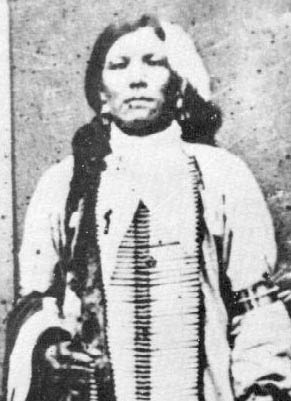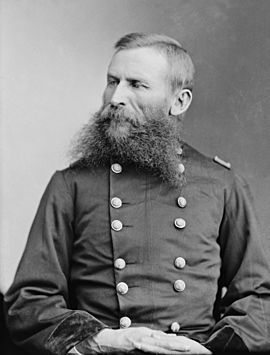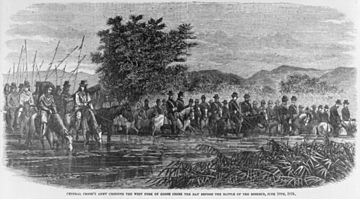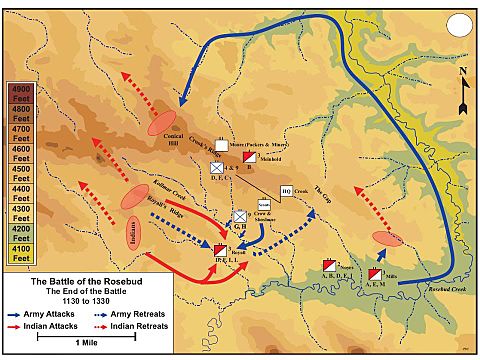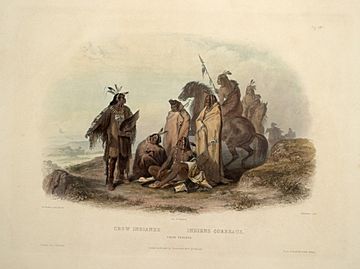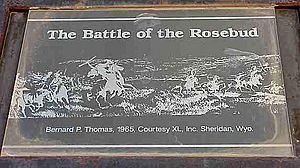Battle of the Rosebud facts for kids
Quick facts for kids Battle of the Rosebud |
|||||||
|---|---|---|---|---|---|---|---|
| Part of the Great Sioux War of 1876 | |||||||
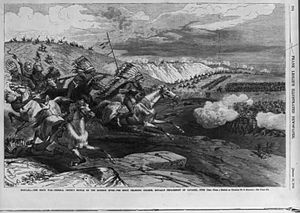 "Battle on the Rosebud River", 1876 |
|||||||
|
|||||||
| Belligerents | |||||||
| Lakota Sioux Northern Cheyenne |
Crow Shoshoni |
||||||
| Commanders and leaders | |||||||
| Crazy Horse | Plenty Coups (Crow) Washakie (Shoshoni) |
||||||
| Strength | |||||||
| ~1,000–1,800 | ~950 soldiers 175 Crow 86 Shoshoni ~100 armed civilians |
||||||
| Casualties and losses | |||||||
| 13–36 killed 63–100 wounded |
U.S.: 14–28 killed; 43–46 wounded Crow Scouts: 1–5 killed Shoshoni Scouts: 1–8 killed |
||||||
The Battle of the Rosebud happened on June 17, 1876, in what is now Montana. It was a big fight during the Great Sioux War of 1876. The battle was between the United States Army and its allies, the Crow and Shoshoni people. They fought against a large group of Lakota Sioux and Northern Cheyenne warriors.
The Cheyenne people called this battle the Battle Where the Girl Saved Her Brother. This name came from a brave moment during the fight involving a woman named Buffalo Calf Road Woman. The U.S. Army, led by General George Crook, was stopped by the Native American forces, led by Crazy Horse. General Crook had to wait for more soldiers before he could continue his mission later that summer.
Contents
Why the Battle Happened
After winning a conflict called Red Cloud's War, the Lakota and Northern Cheyenne signed a peace agreement in 1868. This agreement, the Treaty of Fort Laramie (1868), gave them a special area of land called a reservation. This land included the Black Hills in what is now South Dakota. They also got a large area of "unceded territory" in Montana and Wyoming. This land was only for the Native Americans. Other people, except U.S. government workers, were not allowed to enter.
In 1874, gold was found in the Black Hills. This made the U.S. government want to buy the land from the Native Americans. The U.S. told all Lakota and Cheyenne groups to come to the reservation by January 31, 1876. They wanted to talk about selling the land. Some groups, like those led by Sitting Bull and Crazy Horse, did not go. When the deadline passed, the U.S. Army tried to force them onto the reservation. The first military trip in March 1876 failed. It ended with the Battle of Powder River.
The Army's Plan to Find the Native Americans
In June 1876, the U.S. military started fighting again. They planned a three-part attack into the Bighorn and Powder river areas. Colonel John Gibbon led soldiers from the west. General Alfred Terry, with Lieutenant Colonel George Armstrong Custer, came from the east. General George Crook moved north from Fort Fetterman in Wyoming. Their goal was to find the Native Americans and make them go to the reservation.
General Crook's group was called the Bighorn and Yellowstone Expedition. It had about 993 soldiers, 197 civilian workers, 65 miners, and a few scouts and journalists. Crook's main scout was Frank Grouard. A famous person named Calamity Jane was also with them, dressed as a man.
Crook's group left Fort Fetterman and followed an old trail. They reached the Tongue River in Wyoming on June 8. Crazy Horse had warned that he would fight if Crook crossed the Tongue River. On June 9, Native Americans attacked the soldiers' camp from far away, wounding two men.
Crook waited near the Tongue River for more warriors to join his army. On June 14, 175 Crow and 86 Shoshoni warriors arrived with Frank Grouard. They were happy to fight their old enemies. But they warned Crook that the Lakota and Cheyenne were "as numerous as grass." The Shoshoni and Crow warriors had good weapons. Crook was known for "using Indians to catch Indians," so these allies were very important to him.
On June 16, Crook left his wagons and most civilians behind. He and his soldiers, with the Crow and Shoshoni leading, moved north. They went past the Tongue River to the start of Rosebud Creek. They were looking for the Lakota and Cheyenne. Each soldier carried four days of food and 100 bullets. Crook wanted to march quietly, but the Crow and Shoshoni found a buffalo herd and shot many of them. This made noise.
Crook thought he would soon find a large Native American village on Rosebud Creek. But the village was actually on Ash Creek, west of Rosebud Creek. Crook also did not realize how determined his enemies were. He expected small, quick attacks, not a big battle. The Native American force of almost 1,000 men left their village on June 16. They rode all night to find the soldiers on the Rosebud. They found Crook's scouts around 8:30 in the morning on June 17.
The Battle Begins on the Rosebud
On June 17, 1876, Crook's soldiers marched north along the Rosebud Creek. The happy mood from when the Native American scouts arrived was gone. The soldiers were tired from marching 35 miles the day before and waking up at 3:00 AM. At 8 AM, Crook stopped to let his men and animals rest. Even though they were in enemy land, Crook did not set up special defenses. His troops stopped in their marching order.
The Crow and Shoshoni scouts stayed alert while the soldiers rested. Soldiers in the camp started to hear gunshots from the hills to the north. This was where the Crow and Shoshoni were. At first, they thought it was the Crow shooting buffalo. But the shooting got louder. Two Crow scouts rushed into the camp, shouting, "Lakota, Lakota!" By 8:30 AM, the Sioux and Cheyenne were heavily fighting Crook's Native American allies on the hills north of the main army.
The Crow and Shoshoni were greatly outnumbered. They slowly fell back toward the camp. But their fighting retreat gave Crook time to get his soldiers ready.
A Long and Spread-Out Fight
The battle lasted for six hours. It was made up of many separate attacks and counter-attacks by Crook and Crazy Horse. The two sides spread out over an area three miles wide. The Lakota and Cheyenne split into several groups as the battle went on. The soldiers could stop the Native American attacks and make them retreat. But they could not catch and defeat them completely.
Crook first told his soldiers to take control of the high ground north and south of Rosebud Creek. He sent Captain Van Vliet with two groups of soldiers to hold the hills south of the Creek. This was to protect against an attack from that direction. In the north, Major Chambers and Captain Noyes led their soldiers forward. They formed a line and moved toward the Lakota. They moved slowly because Native Americans on the hills to the northeast were shooting at them from the side.
To speed up the attack, Crook ordered Captain Anson Mills to charge the Lakota with his cavalry. Mills' mounted charge surprised the Native Americans, and they pulled back along the ridge. Mills quickly gathered three groups of soldiers and led another charge. This pushed the Native Americans northwest to the next hill. As he prepared to push them further, Mills received orders from Crook to stop and get ready to defend. Chambers and Noyes brought their forces forward to support Mills. Within minutes, they joined him on top of the ridge. Most of Crook's army, along with the civilian workers and miners, took over a hill they called Crook's Hill. Crook set up his headquarters there around 9:30 AM.
The Girl Who Saved Her Brother
During Mills' advance, a special event happened that gave the battle its Cheyenne name. A Cheyenne warrior named Comes in Sight had his horse shot. As he ran away on foot from Mills' soldiers, his sister, Buffalo Calf Road Woman, rode to save him. Comes in Sight jumped onto her horse, and they both escaped safely.
Mills was very impressed by the many Native Americans fighting in front of him. He said, "They were the best cavalry soldiers on earth. In charging up toward us they exposed little of their person, hanging on with one arm around the neck and one leg over the horse, firing and lancing from underneath the horses' necks, so that there was no part of the Indian at which we could aim."
Crook's first charges took control of important areas but did not hurt the Native Americans much. The attacks scattered them, but they did not leave the battlefield. After falling back, the Lakota and Cheyenne kept shooting from a distance. They attacked several times in small groups. When the soldiers counterattacked, the warriors quickly rode away on their fast horses. Crook realized his charges were not working well.
Crook wrongly believed that the Lakota and Cheyenne were fighting so hard because they were protecting their families in a nearby village. He ordered Captains Mills and Noyes to move their cavalry from Crook's Hill. They were to go east, following the Rosebud north, to find this suspected village. He also called Van Vliet's soldiers from the south side of the Rosebud to help him on Crook's Hill.
While Mills and Noyes searched for a village that did not exist, the situation for Lt. Colonel William B. Royall, Crook's second-in-command, got worse. Royall had chased the Native Americans attacking Crook's camp with six companies of cavalry. Royall moved quickly along the ridge to the northwest, about a mile away from Crook. They were separated by a valley. The Lakota and Cheyenne then focused their main attacks on Royall. He was in danger of being cut off from Crook. Seeing this, Crook sent orders for Royall to pull back to Crook's Hill. Royall only sent one company to join Crook. He later said his forces were too busy fighting to leave.
Royall's situation kept getting worse. He tried to move all his soldiers across a creek, but the Native American fire was too heavy. Next, he started to pull back southeast along the ridge. A large group of Sioux and Cheyenne left the fight against Crook's main forces. They bravely charged down the valley, going all the way to the Rosebud. When Captain Guy V. Henry was wounded, his soldiers started to panic. But the Crow and Shoshoni arrived and pushed the Lakota and Cheyenne back. Crook also sent two infantry companies to a nearby hill. They helped Royall with long-range rifle fire, which kept the Lakota and Cheyenne away. The Lakota and Cheyenne did not try any serious attacks on the infantry. They respected the longer range of their rifles compared to the carbines the cavalry carried. The Crow, Shoshoni, and the two infantry companies likely saved Royall's group from being defeated.
Around 11:30 AM, Royall continued to pull back to the southeast and took a new defensive spot. He was being attacked from three sides. From his headquarters, Crook realized that Royall needed help. Only Mills' force, which was two or three miles away down Rosebud Creek, could provide it. Crook sent orders to Mills, telling him to turn west and attack the Native Americans who were pushing Royall.
Around 12:30 PM, Royall began another retreat into a ravine. His cavalry got back on their horses. They prepared to ride through gunfire to reach the safer main position of Crook's army. As the U.S. cavalry started their dash, the Crow and Shoshoni scouts charged the Lakota and Cheyenne who were chasing them. This greatly reduced the pressure on Royall's men. Two companies of infantry provided covering fire from the northeast side of the ravine. Royall's group suffered most of the U.S. casualties during the battle.
Mills arrived too late on the Lakota and Cheyenne side to help Royall's retreat. But his unexpected appearance made the Lakota and Cheyenne stop fighting and leave the battlefield. The cavalry chased the Native Americans but soon gave up. The Battle of the Rosebud ended around 2:30 PM.
Who Won and What Happened Next?
The number of people hurt or killed on both sides is not exactly known. Crook said 10 of his soldiers were killed and 21 wounded. His assistant, John Gregory Bourke, added that 4 of the wounds were very serious. He said the total casualties were 57. Frank Grouard said 28 soldiers were killed and 56 wounded. Estimates for Crow killed range from one to five, and for Shoshoni, from one to eight.
The number of Lakota and Cheyenne casualties is also unclear. Estimates of those killed range from 10 to 100. The Crow reportedly took 13 scalps. Crazy Horse later said that the Lakota and Cheyenne had 36 killed and 63 wounded. How he got such exact numbers is unknown. It's unlikely the Native Americans kept detailed records of casualties from all the different groups fighting.
Compared to the usual quick attacks of the Plains Native Americans, the Battle of the Rosebud was a long and bloody fight. The Lakota and Cheyenne fought very hard. They were willing to suffer losses rather than stop fighting. The delaying actions by Crook's Native American allies at the start of the battle saved his army from a terrible surprise attack. The help from the Crow and Shoshoni scouts throughout the battle was very important. They helped Crook avoid a disaster.
Crook said he won because his army stayed on the battlefield at the end of the day. But his actions after the battle suggest otherwise. He was worried about his wounded soldiers and was low on supplies. Crook went back to his camp on Goose Creek, near Sheridan, Wyoming. He stayed there for seven weeks, waiting for more soldiers. He did not take part in the Battle of the Little Bighorn eight days later. Crook's Crow and Shoshoni allies left the army for their homes soon after the battle. The Lakota and Cheyenne returned to the battlefield after Crook left. They piled up rocks where important events happened during the battle. Some of these rock piles are still there today.
The Battle Site Today
The place where the battle happened is now protected as the Rosebud Battlefield State Park in Big Horn County, Montana. This site was added to the National Register of Historic Places in 1972. It was also named a National Historic Landmark in 2008.
Who Fought in the Battle
United States Forces
- Brigadier General George Crook led the Department of the Platte.
- 2nd United States Cavalry Regiment: Companies A, B, D, E, and I
- 3rd United States Cavalry Regiment: Companies A, B, C, D, E, F, G, I, L, and M
- 4th United States Infantry Regiment: Companies D and F
- 9th United States Infantry Regiment: Companies C, G, and H
- Crow Scouts
- Shoshoni Scouts
- Civilians
Native American Forces
- Crazy Horse
- Lakota (Sioux) groups:
- Oglala (Scatters Their Own)
- Hunkpapa (Camps by the Horn)
- Sans Arc (They have no bows)
- Sihasapa (Black Feet band of Lakota)
- Miniconjou (Plants by the water)
- Two Kettles
- Brulé (Burnt Thighs)
- Dakota (Santee Sioux)
- Northern Cheyenne
- Northern Arapaho


